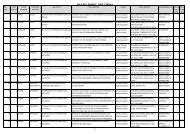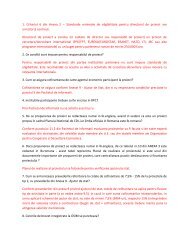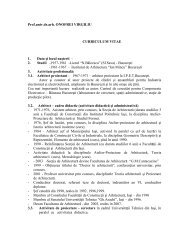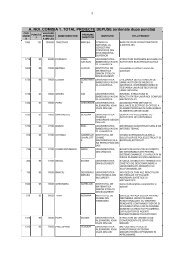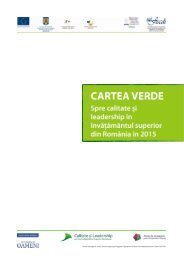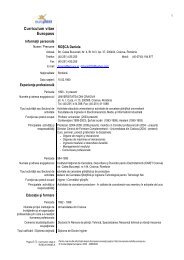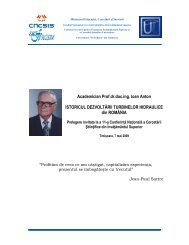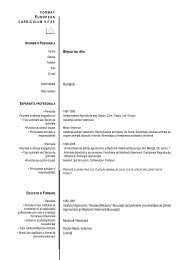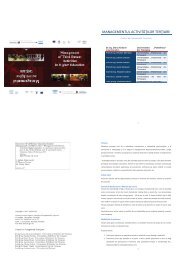Modul de formare-Managementul resurselor financiare - uefiscdi
Modul de formare-Managementul resurselor financiare - uefiscdi
Modul de formare-Managementul resurselor financiare - uefiscdi
- No tags were found...
You also want an ePaper? Increase the reach of your titles
YUMPU automatically turns print PDFs into web optimized ePapers that Google loves.
The actions taken will target mainly the share of budgetary allocations from total revenue of the<br />
university, and the relationship between budgetary allocations and their incomes, having an<br />
impact on: the education offer, the proportion number of teachers – number of stu<strong>de</strong>nts, the<br />
material basis, the scientific research activity, the university management.<br />
The European countries are always concerned about the public funding in the higher education<br />
institutions issue. Thus, the main features of the funding forms for the higher education in<br />
Europe are 22 :<br />
The funding formulas used to the public funds allocation are generally based on the volume<br />
of activities, often measured by the number of stu<strong>de</strong>nts enrolled in the institution;<br />
The performance indicators are based on stu<strong>de</strong>nt outcomes, indicators used in the funding<br />
formulas in most of the countries;<br />
There are different approaches to the use of the performance indicators in <strong>de</strong>termining the<br />
funding formulas: in some countries, a very small percentage of the public funding is<br />
allocated based on the performance indicators, while in the UK, the global grants for<br />
teaching, operations and research <strong>de</strong>pend directly on the institutions’ performance. Besi<strong>de</strong>s<br />
taking into account the volume of activities and the stu<strong>de</strong>nt outcomes, some countries use<br />
other mechanisms for the public funds allocation, which gives them some <strong>de</strong>gree of stability<br />
in terms of resources allocation from year to year.<br />
In 12 countries the public funds are granted in accordance with the performance contract.<br />
The performance contracts <strong>de</strong>fine the objectives in accordance to the national<br />
priorities. These contracts can cover most of public funds allocated to the institutions or only<br />
a small part for specific projects. In the cases where the previous contract influences the<br />
amount of funds granted by the new contract, there are taken into account qualitative<br />
indicators on the number of graduates or the general quality of the institution management.<br />
The public research funds are allocated taking into account the different mechanisms.<br />
The funds are allocated through competition for specific research projects or programs, in<br />
each country. This system of funds awarding is already or is about to become, the main<br />
source of public funding for research in several countries. Almost all the countries also grant<br />
subsidies for the fundamental research, which are not related to specific research<br />
projects. The calculation of the amount awar<strong>de</strong>d for research grant may <strong>de</strong>pend on the<br />
institution costs or on research performance. Most of the countries take account of both<br />
aspects, which creates competition among institutions.<br />
Almost everywhere, the higher education institutions are receiving public funds in the form<br />
of global grants. The global grants cover several expenditure categories established by the<br />
institution. However, in some countries where global subsidies are granted, particularly in<br />
Central and Eastern Europe, a draft budget must be approved by the government.<br />
There are many measures of accountability of the use of public funds, such as the financial<br />
audits, the performance indicators, the annual reports, the information gathering for<br />
databases, the publishing of the internal evaluation results and other methods to spread the<br />
information.<br />
The most important authorized sources for private funds are: the donations and the legacies<br />
from the private entities, the partnerships representing the research contracts between the<br />
higher education institutions and the private contractors, the fees from services. With very<br />
22 Guvernarea în învăţământul superior din Europa. Politici, structuri, finanţare şi corp aca<strong>de</strong>mic, Eurydice 2008,<br />
http://eurydice.org<br />
24



